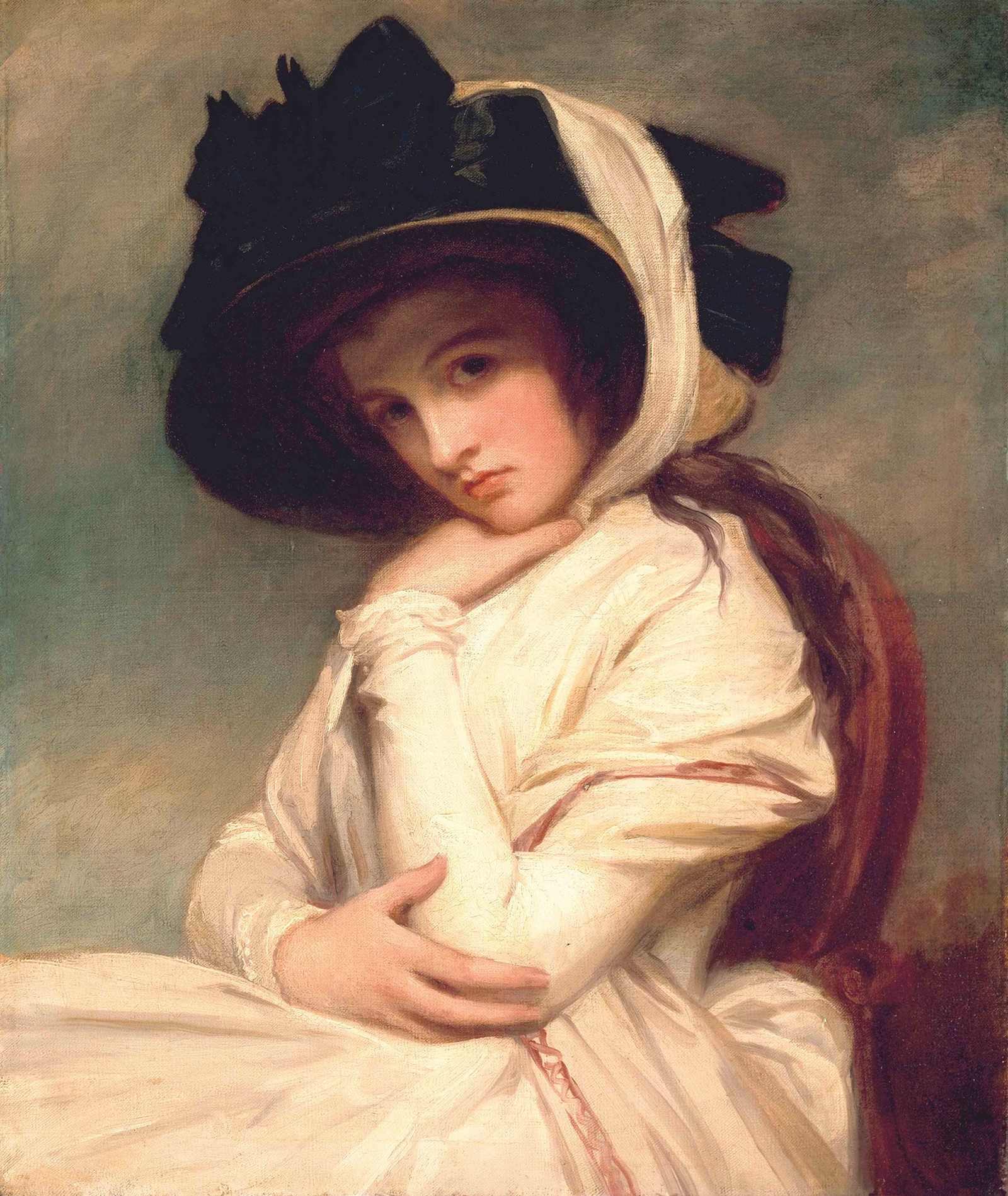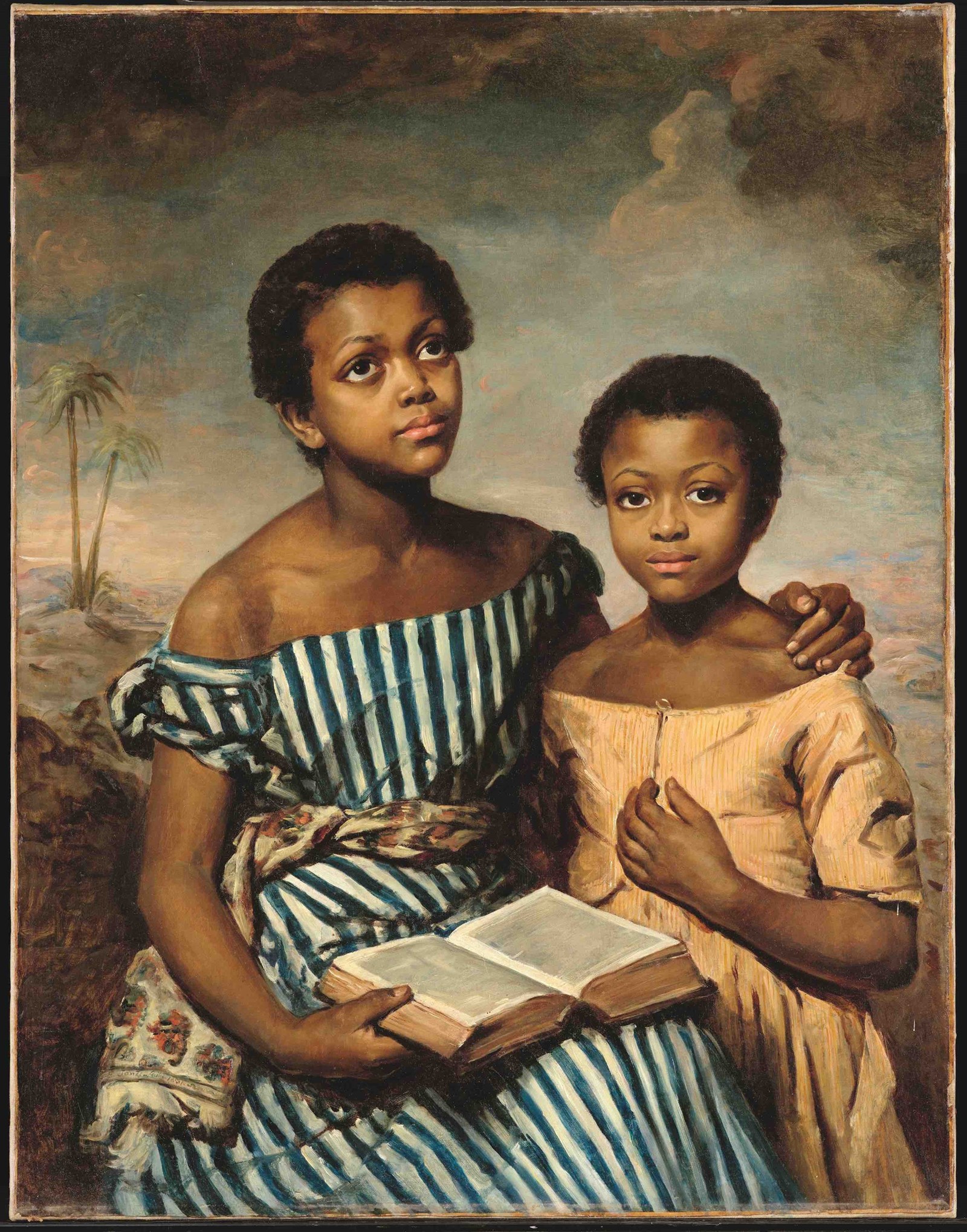Girlhood Studies: How has visual culture shaped ideas of female adolescence? This excerpt is taken from Look Again: Girlhood by Claire Marie Healy.
Though we might be able to tell that these two paintings are of the same young woman, we probably wouldn’t bet on it.


They are two of many paintings Regency-era painter George Romney made of the teenaged Emma Hart (married name Hamilton), already described as ‘London’s biggest celebrity’ by the time she found herself posing for the established artist. At this time of their meeting, she had already metamorphosed several times – from out-and-out poverty to table-dancing to out-of-wedlock pregnancy, to her latest status, at the time of these portraits, as lover to a wealthy gentleman – though it would be some years until her notable tenure as Admiral Nelson’s great love. Both paintings might depict Hart aged seventeen, but it is in their framing that they diverge so tellingly.
In Emma Hart, later Lady Hamilton, in a Straw Hat c.1782–94 (also known as Emma Hamilton as a Young Girl (aged 17)), she is the picture of innocence. Her dress and straw hat are of a demure, everyday quality, and her pose is hunched, as if she is making herself smaller. In Emma Hart as Circe 1782, our picture of Hart rearranges itself: like a supermodel in close-up on a fashion cover, her gaze is direct and her lips a little open; her clothes, hair and backdrop are daubed, not concrete, mere draping for her beauty. If Hart is meant to be the seductive Greek goddess Circe here, there are no clues in the painting itself. Instead, Romney reduces his subject to the myth’s core archetype: that of the predatory woman.
What came first: Hart’s reputation as a seductress beyond her years, or Romney’s depiction of her as such? When I look at her I think about the depictions of teenage celebrities of other eras: of Brooke Shields, portrayed as a sexual, knowing creature in Richard Avedon’s infamous Calvin Klein advertising campaign, when she is just 14 years old. I also note how, in the titles of both works, Hart is described ‘as’ something else: in each, she plays a role given to her by another. Romney’s paintings of Hart tell us something about how girlhood always feels like a period of acting-something-out. Much later, the muse would become known for her ‘attitudes’: a kind of early performance art in which Hart played different characters in tableau for her friends to guess, like living versions of those portraits. Called ‘the most extraordinary compound I ever beheld’ by a contemporary diplomat, Hart’s unpindownability was always inseparable from her own creative charge.

Characters from literature and legend have always stuck to perceptions of girlhood. The first time children come across figures subtly signposted as teenagers, for instance, is in bedtime fairy tales. The painters of the Pre-Raphaelite movement drew from this well of British storytelling, especially when it came to their cast of female subjects: I am thinking of much-reproduced paintings such as John William Waterhouse’s The Lady of Shalott 1888 or John Everett Millais’s Ophelia 1851–2.
[On Ophelia] “Drenched with symbolism right down to the flowers gently floating away from the subject’s upturned palms – poppies for death, pansies for love in vain, daisies for innocence like a Marc Jacobs fragrance – the surface level of the painting’s girl’s-world aesthetics reverberate well into our own time” – Claire Marie Healy
The latter was praised at the time for its impressively accurate study of nature, an assessment that entirely leaves out the girl at its centre: Hamlet’s romantic interest Ophelia, whose suicide by drowning occurs off-stage in Shakespeare’s play. Drenched with symbolism right down to the flowers gently floating away from the subject’s upturned palms – poppies for death, pansies for love in vain, daisies for innocence like a Marc Jacobs fragrance – the surface level of the painting’s girl’s-world aesthetics reverberate well into our own time. What GCSE artist hasn’t conducted a photoshoot of their friend in the bath with all their clothes on, as Millais does with his model? The doomed, white dead teenage girl continues to merit cultural fascination: Ophelia’s blank gaze and horizontal body floats just downstream from Laura Palmer, ‘wrapped in plastic’ in David Lynch’s Twin Peaks. But Millais’ painting is also lasting because it speaks to the pleasure teenage girls take in how things look: the way girls today might describe objects as simply ‘aesthetic’ or, in the words of something I saw on TikTok, their need ‘to romanticise absolutely fucking everything’.

The beautiful surfaces afforded by notions of girlhood have also been put to more explicit political use, as in Emma Soyer’s recently discovered Two Children with a Book 1831.
Due to its dating and the depiction of the girls, Emma Soyer’s painting was probably intended to promote abolition in the Caribbean. But what was most likely a practical commission at the time becomes charged with something else in the British gallery space where portraits of girls – and girls reading – are historically white. In situ, one kind of protest is fashioned as another: a certainly sentimental, but refreshingly tender, image of two young Black women (sisters, we think), where the elder safeguards the younger in an intimate space that feels out of its own time. Right now, on social media, many Black teenage girls are using photography, filmmaking, makeup and dress to issue a challenge to racist assumptions about who gets to represent softer, more romantic aesthetics. Viewed in this context, Soyer’s airbrushed lens on these two girlhoods, and two lives that were once really lived, glows.
Look Again: Girlhood by Claire Marie Healy is published by Tate and is out now.